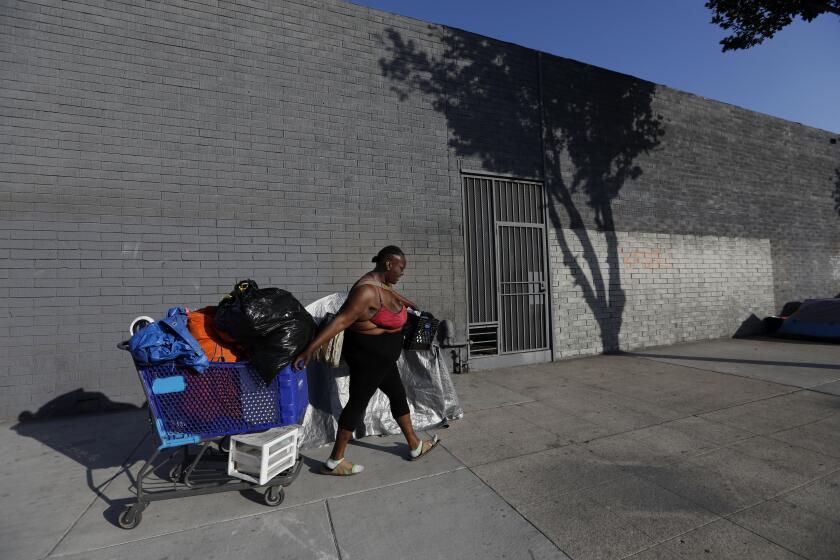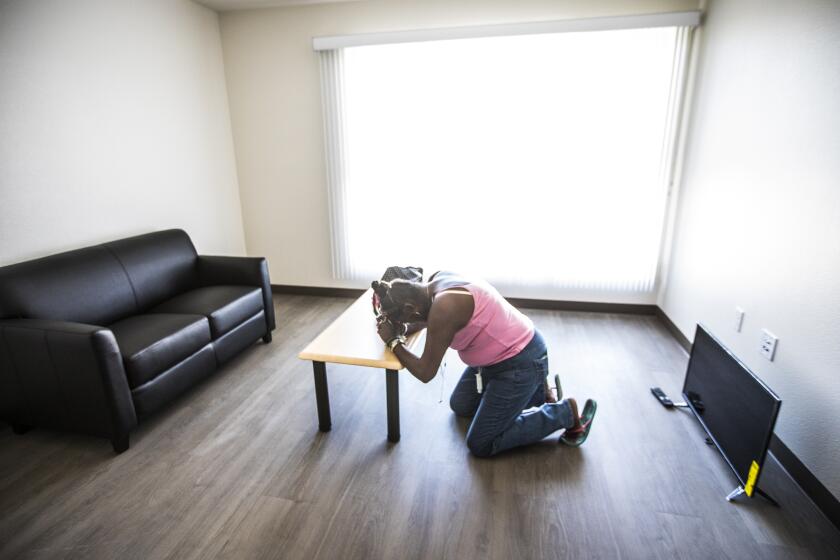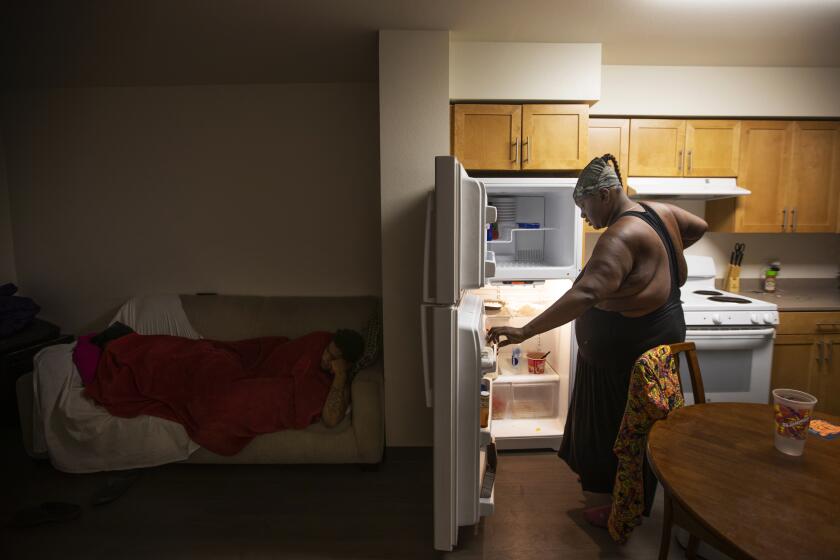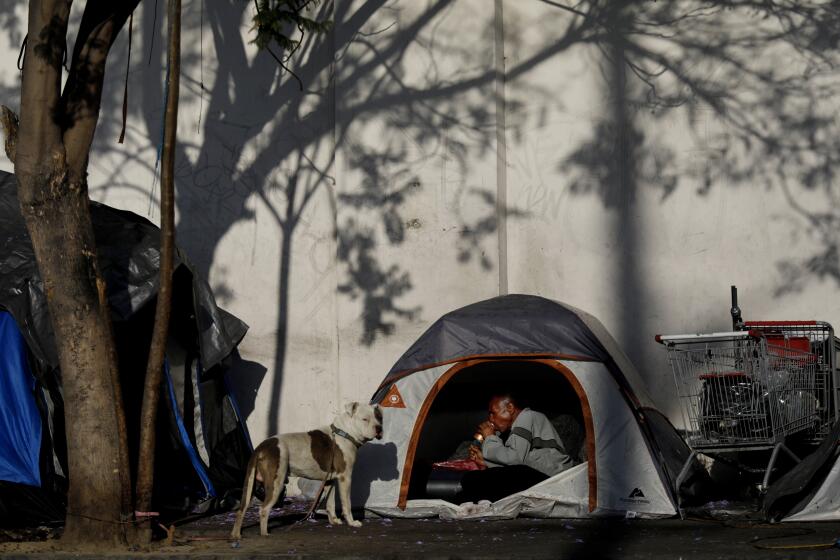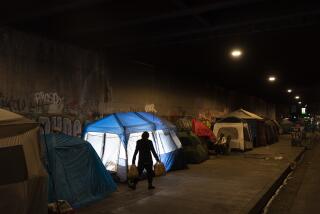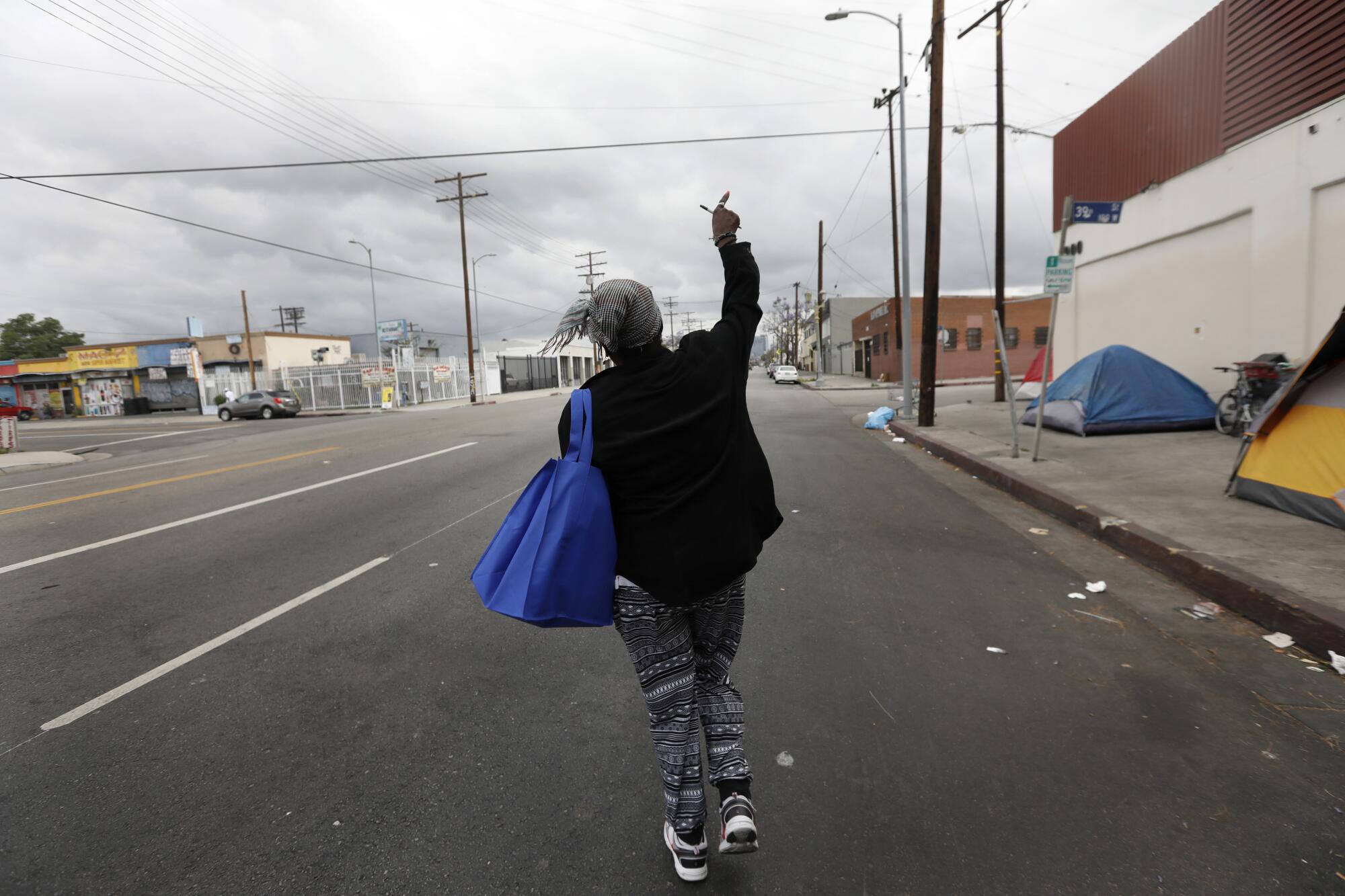
First in a series: Big Mama and her neighbors live in a homeless encampment in Los Angeles. Through a special housing initiative they’ll soon have the opportunity to move into apartments.
- Share via
Last year in May, life got even nastier for the homeless of Broadway Place.
First came the car crash.
A silver Accord ran the stop at 39th Street, slammed into a red Infiniti and careened into an encampment, taking out Horace and Wendy’s tent and hitting the big man known as X.
Big Mama, a senior resident, heard the screeching tires and thump.
The Accord sat on the sidewalk. It had rammed a black love seat through one side of the tent. Milk crates, water bottles and clothing bags lay scattered amid bicycles, chairs, a shopping cart.
Transmission fluid pooled in the gutter, where urine bottles had landed. Shards of glass sparkled on the asphalt.
Neither Horace nor Wendy was home, and X suffered only a minor injury.
Two days later came the stabbing.
A young man pulled up in a Nissan and started yelling at the neighbor who lived in a tent mid-block with his three dogs, including a pit bull named Caesar.
Big Mama watched as insults escalated into shoving, slapping and punching.
Then the troublemaker ran to the car and came back with what looked like a pair of scissors. He took a swing, a penitentiary stab just below the ear.
The neighbor screamed, hand to his bleeding neck. He reached for a broom handle, chased the assailant, then returned to his tent, feeling faint. He went to the hospital. Weeks would pass before he returned.
Big Mama was shaken. Broadway Place in South Los Angeles was her home. Her tent wasn’t much but it was all she had, and the residents of this ragged little community were her friends.
On the best days, she was grateful for what she had found on the street, the protection and mutual understandings. They looked out for one another. But at moments like these, she knew this was no place to live.
But if not here, where?

::
For nine years, Big Mama had looked out upon the growing number of tents on her street and witnessed firsthand the defining tragedy of life in Los Angeles today.
Homelessness had become a crisis of historic proportions. It destroyed lives, consumed civic discourse, threatened political careers and exhausted public patience. Social services struggled to keep up.
Big Mama knew agencies were trying to help her, but what she didn’t know was that she and her neighbors had been singled out for a special program that would move them off the street and into new apartments. It would transform their lives in ways they could only have imagined.
The program, called Encampment to Home, represented a radical shift in tackling the crisis. The old model — disparate agencies working person to person on the street — wasn’t working. Neighborhoods were being overrun.
Encampment to Home instead would target entire encampments, moving their residents en masse into supportive housing.
The city and county had little choice but to try something new.
Billions of dollars from two ballot measures were about to become available for housing and homeless services, and the number of people living on the street or in shelters was only getting worse.
If successful, Encampment to Home could serve as a model for future efforts as the county began to undertake a massive relocation program that few cities in America have attempted.
The work in the months ahead would be frantic and frustrating, and the program’s results would be hard to measure. As much as homelessness is the absence of housing, it is much more than that. It touches upon mental illness, addiction and physical ailments arising from a life of poverty. It requires men and women to overcome the past that drove them into the street and find hope in the future.
Not everyone is able to.
As Big Mama and her neighbors would learn, the street they most needed to escape was the street within.
::
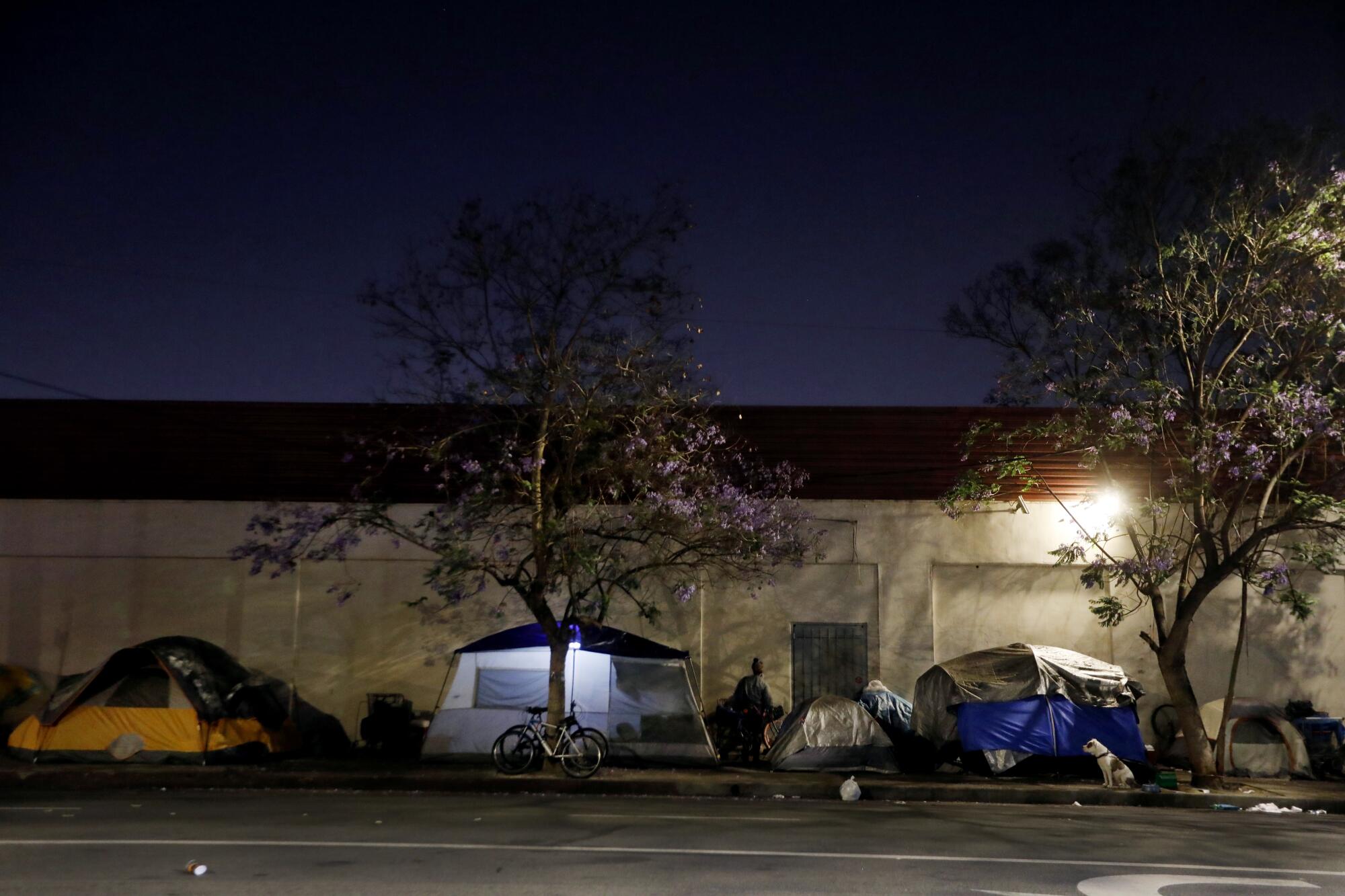
Big Mama, 51, didn’t want to be known by her given name, Yvette Grant. It belonged to a past she seldom talked about. Her street name reflected the respect she believed she was owed as the matriarch of Broadway Place.
Her friends agreed. She had lived on this block the longest and tried to keep everyone in line. “I stay in my lane,” she said. “I pick up my trash and keep down the drama and noise.”
She came to California from Texas on a Greyhound bus 20 years ago. She didn’t get along with her family. She left her children behind and arrived with no money, no place to stay.
Skid row became her home: the Los Angeles Mission and the Anne Douglas Center for Women. At first, street life was a party. She and her friends called themselves the Downtown Girls. After two years, the scene soured in a cycle of betrayal and violence.
She got pregnant, and for a time, she lived with her baby daughter and the girl’s father in north Long Beach. She studied cosmetology and culinary arts at Long Beach City College.
But she moved back to Los Angeles and for a while lived in a shelter a block away on 38th Street. She hated it: too many lines, too many rules, too many outbursts.
Her first tent burned up when a man living next door started a fire with a candle. The night sky turned orange, and Big Mama got out barely in time.
She pitched other tents elsewhere and finally settled on Broadway Place just south of 39th Street.
Her blue-and-green tent measured 10 feet by 10 feet and sat on wooden pallets. She had a full-sized mattress and a bucket for a toilet. Plastic bins kept her clothes dry and prevented roaches and ants from getting into her food. To ward off rats, she whipped up a concoction of mothballs, garlic and bleach. Sometimes it worked.
Her neighbor was Venisha Ross, though everyone called her either Grand Baby or Top Shelf. She was 46, had deep brown almond eyes and favored hoop earrings that nearly touched her shoulders. She lived on the street, but she would never get in the way of her cool. That’s why she was Top Shelf, just out of reach.
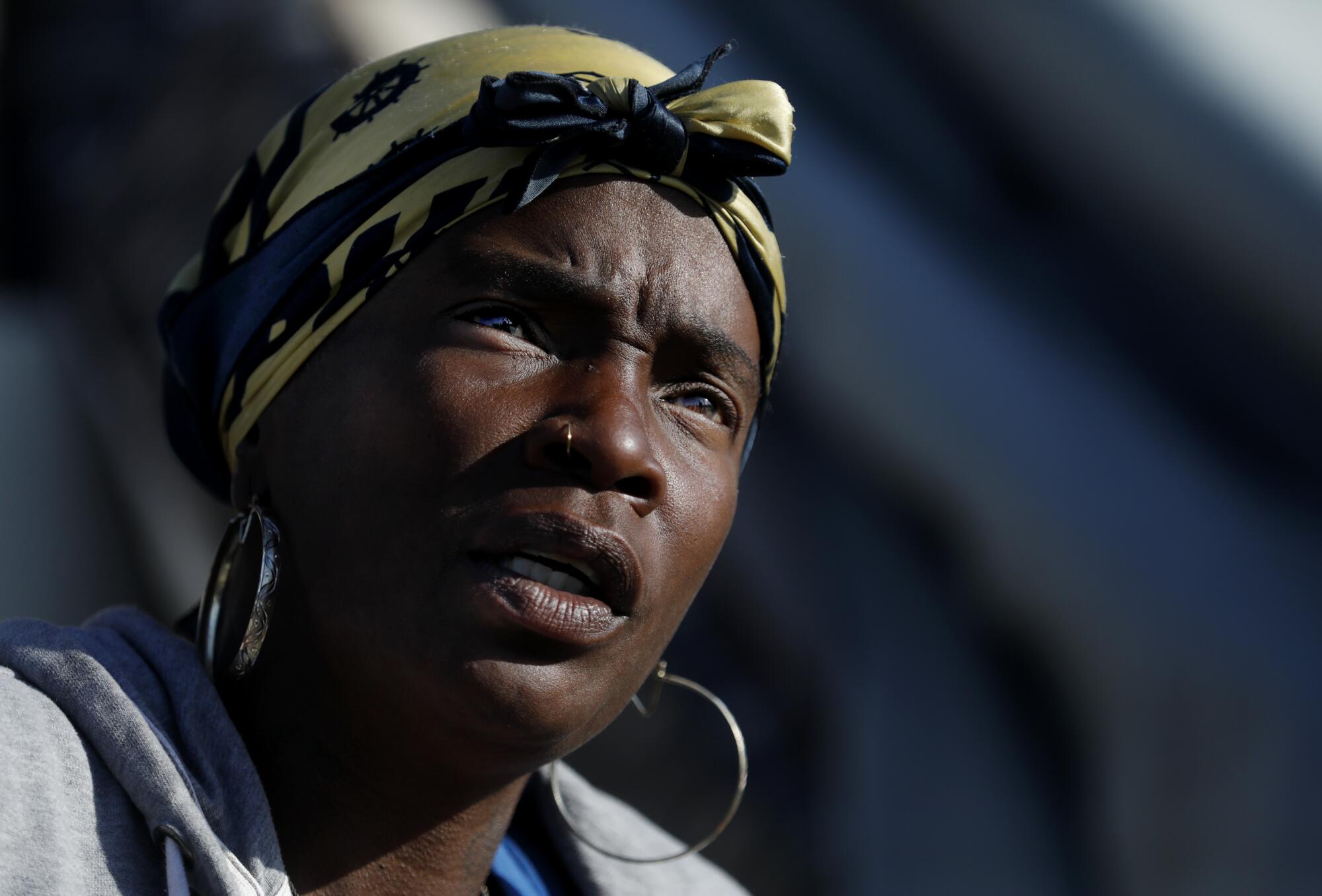
She and Big Mama were tight, and their friendship served as protection. TRUST NO MAN read the tattoo on Top Shelf’s arm. She kept a wooden club near her door.
Leneace Pope, Niecy for short, lived beside them. She had moved to Broadway Place four years earlier when she was 29. Niecy had lived on and off the streets since 2004. A large woman, she could take care of herself.
Together the three tents belonging to the women anchored one end of this encampment, whose residents were all African American.
While foot traffic from the nearby shelter, apartments and businesses brought a mix of race, ethnicities and backgrounds to the street, this stretch of sidewalk on Broadway Place represented one of the starkest realities of homelessness in Los Angeles.
Black people live on the streets of this city at a rate far greater than their share of the general population.
This over-representation was the subject of a 2019 study by the Los Angeles Homeless Services Authority that attributed its cause to “racism, discrimination and unconscious bias in our public systems and institutions.” This bias, as the report argued, has extended into housing and employment, two crucial factors affecting an individual’s ability to get off the street.
On Broadway Place, the racial component of homelessness warranted only a shrug. Its residents had only themselves to count on. Opportunity had passed them by.
“America is just the land we’re living in,” Big Mama said.
::
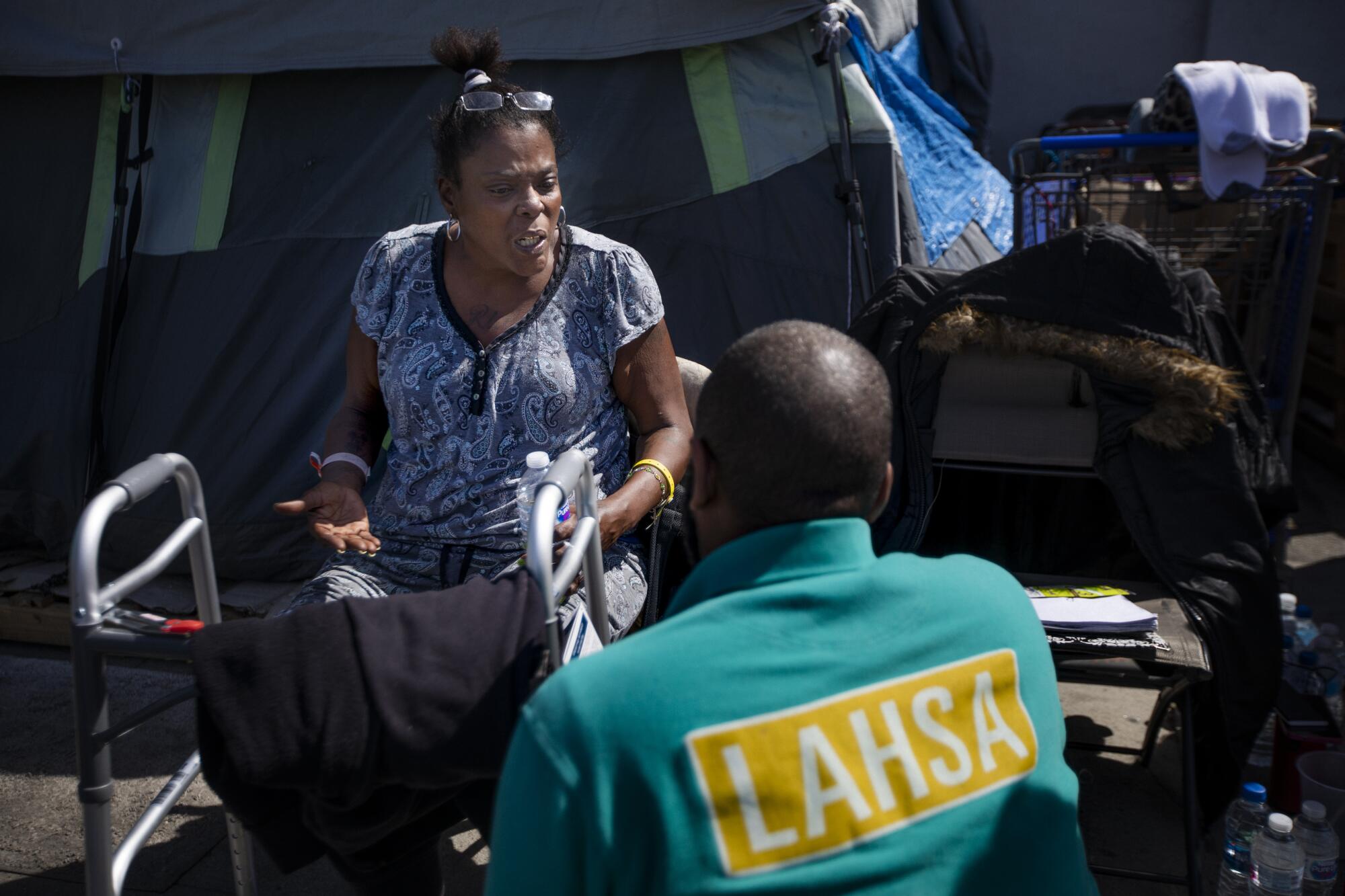
One Tuesday morning early last year, Big Mama was holding court from one of her chairs on the sidewalk. Outreach workers had pulled up to check on her. Suffering from back pain, she had just been released from Centinela Hospital, where doctors sought to stabilize her spine by fusing her lower vertebrae.
“I’m tired today,” Big Mama said. “I’m irritated.”
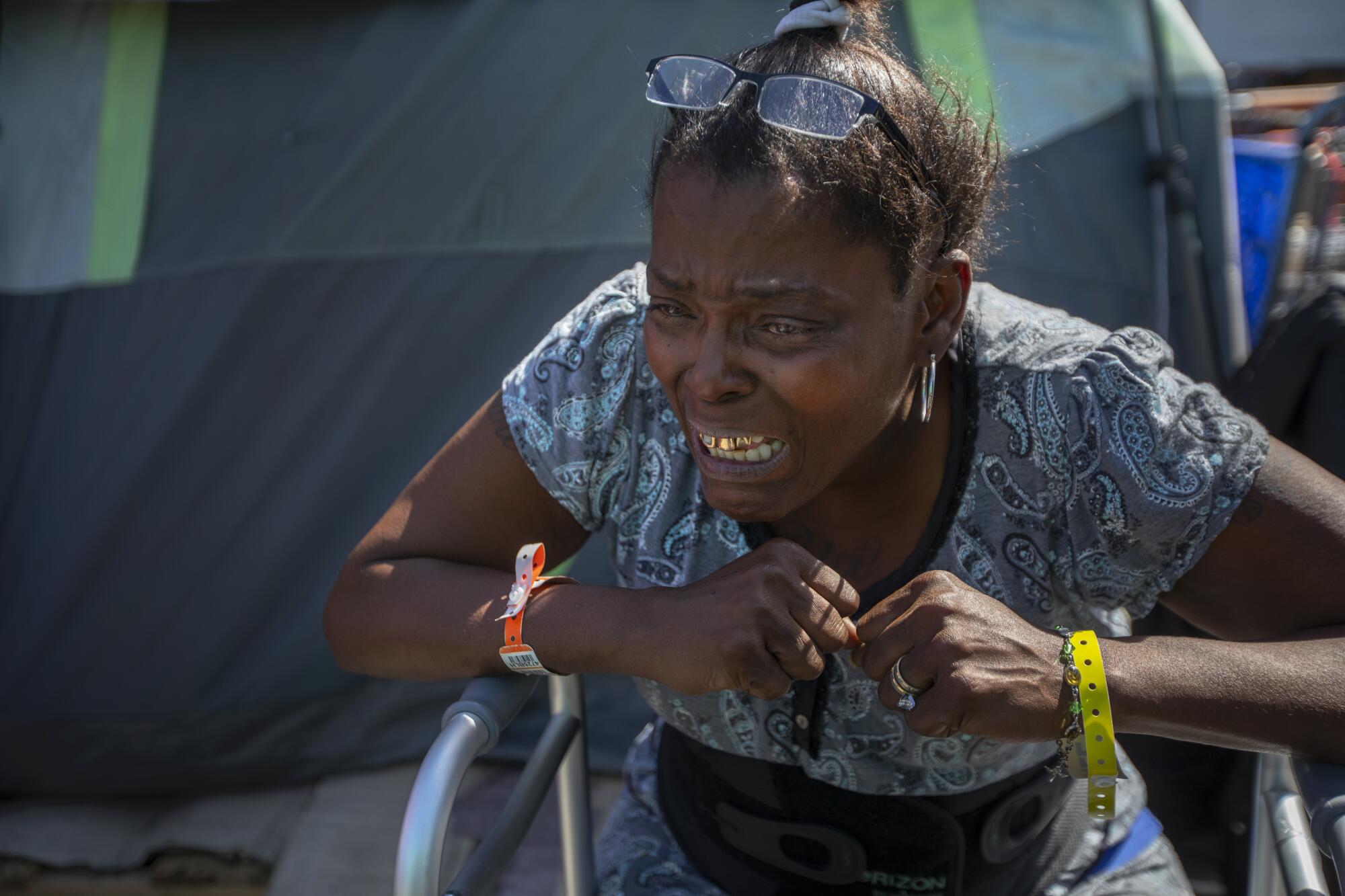
Top Shelf and Niecy circled around her. The three women had matching tattoos on their hands: PPG, in solidarity with their cartoon superheroes: Bubbles, Blossom and Buttercup of the Powerpuff Girls.
Misfortune had drawn them together, and solidarity kept them safe. On the streets, single women were often targets of assault, sexual violence and coercion, and their three tents, side by side, offered protection from everything but the fears and apprehension that visited them whenever they were alone.
“It’s too damn cold out here,” Niecy said. “The rats going through our stuff.”
“We ain’t talking about no house mouses,” Top Shelf said.
“Rats look like guinea pigs,” Niecy said.
“They bit a big ol’ hole,” Big Mama said, “and just step in and say, ‘How you doing?’ and eat all your stuff.”
Big Mama tugged at a brace cinched at her waist around a gray paisley track suit. She knew the streets were no place to recuperate, but she missed her friends and believed that she was needed here.
“I’m a blessing to this street,” she said.
Yet the hardships wore upon her.
“Why should we have to live this way, having to throw our feces into the sewer?” she said. “They bring us cold food and used clothes. What do they think we are? They give us a tent once a year. We deserve better.”
She coughed and yelled, crying one moment and laughing the next.
Then she stopped and looked up. Black smoke billowed into the sunlight two blocks over: another tent fire.
“Oh, Lord,” she said.
Days later, she learned what had happened: The woman who lived there wasn’t willing to have sex, and some men wanted to teach her a lesson.
::
Just north of Martin Luther King Jr. Boulevard, Broadway Place was a magnet for tents. The street was ignored by commuters, and the sidewalks were extra wide. A long one-story building rose on one side, two jacaranda trees on the other.
The one-hour parking was seldom enforced.
The neighborhood was dominated by the garment industry: wash houses, fabric cutters and dye shops. A former gas station served Mexican takeout, and a fire extinguisher plant on 38th Street had been rebuilt as a homeless shelter.
Other buildings were derelict, waiting to be condemned.
About a dozen people lived in this encampment, ranging in age from their 20s to 60s. Some had been here for nearly a decade, others for just a few months. Some held jobs and took a bus or Uber to work. Others chased the sun or the shade, depending on the season.
A market south of Martin Luther King Jr. Boulevard was their go-to for cigarettes and beer. Bottles shaped like assault rifles and filled with vodka hung from the ceiling behind thick Plexiglas. A few blocks away was a weed shop.
“I never thought I was going to be homeless,” Big Mama said. “It’s sad, and it’s why we smoke the bud and drink.”
She favored Miller High Life, maybe with a little E&J brandy on the side. Top Shelf had her Colt 45s and her stash. It was just enough to survive and forget, the best they could hope for on some days.
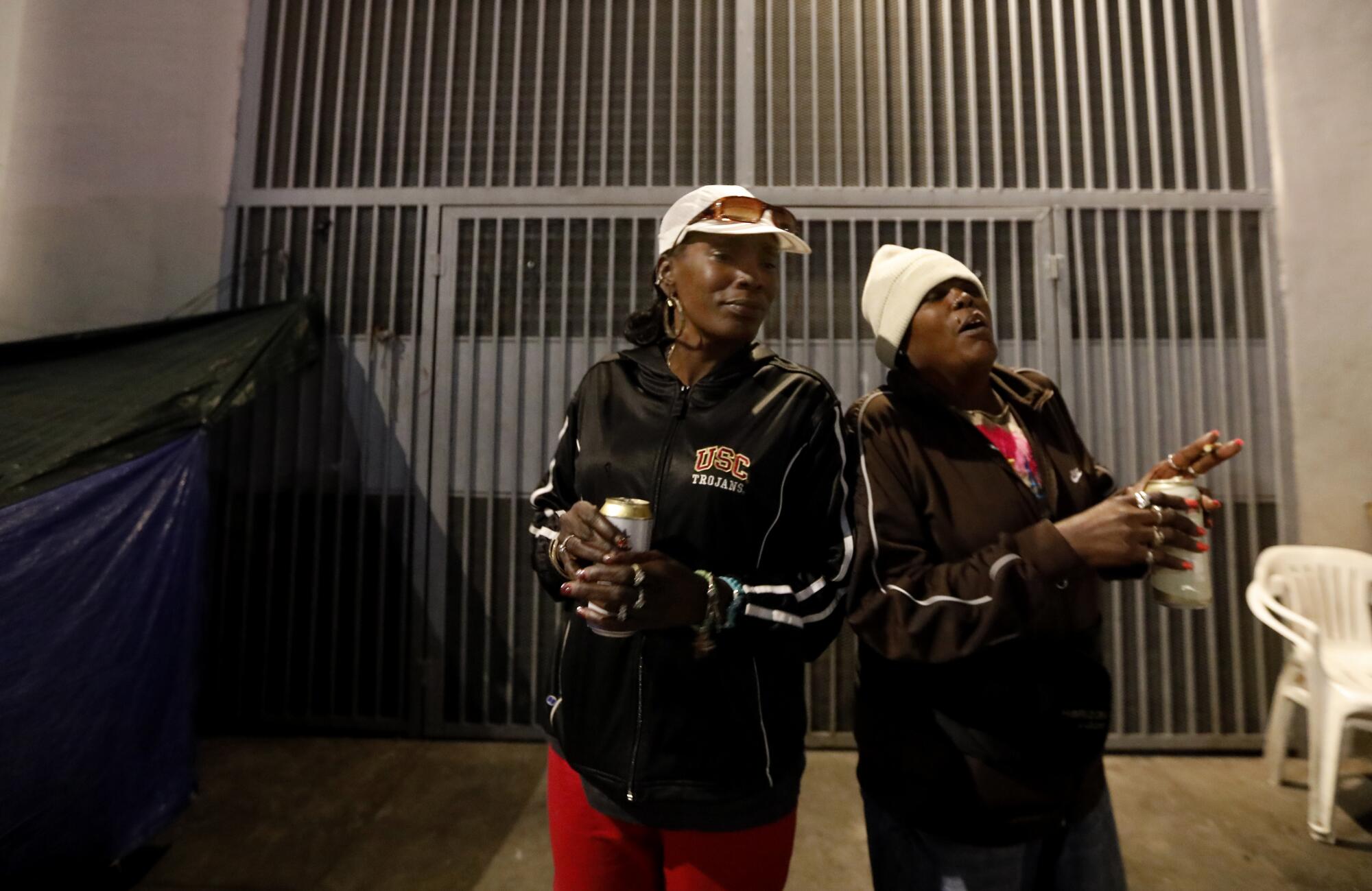
Big Mama had the names of her Texas children tattooed on her neck. On her leg, the name “Donnell” was inked beside a pair of baby feet and a jumping dolphin.
Who’s Donnell?
“I don’t want to talk about that,” she said.
Pain was rarely expressed on the streets. Vulnerability was incompatible with survival, and Big Mama often put up a wall to her past. Her life in Texas was a mystery, and her dreams for the future were unspoken. Homelessness was her shield, a pulpit she found it easier to speak behind.
“All the homeless — the teens, the middle-aged, the old — has a story to tell, and the story is how our families have thrown us away,” Big Mama said. “So we go out on the street to find our new family.”
With only a nylon tent between her and the world, there was comfort knowing that she wasn’t alone with the indignities of urinating in a jar, living without running water or sleeping in fear.
She and her neighbors were family — if not by blood, then by hard experience.
::
By late April, a coalition of city and county homeless agencies, led by United Way and the county Department of Health Services, were meeting regularly downtown. They had given themselves four months to clear two neighborhoods in South Los Angeles of homeless encampments. One was in the vicinity of Broadway Place, the other at Leimert Park.
The timeline for Encampment to Home was ambitious and meant to coincide with the opening of two apartment buildings, located at El Segundo Boulevard and the 110 Freeway and designed and built for low-income residents.
Past efforts — notably Project 50 in 2007 — focused on housing the most vulnerable individuals, rather than entire encampments, and typically took up to a year.
The goal of Encampment to Home was to streamline and expedite the efforts of understaffed and overwhelmed bureaucracies in order to clear sidewalks and show results.
Outreach workers began showing up more often on the streets, but they had been told not to mention Encampment to Home lest they create undue expectations.
“You can freeze to death on the streets, you can burn up on the streets, you can starve on the streets. I have no more energy for any of this.”
— Big Mama
They were skeptical too, especially about the ambitious timeline, and didn’t want to risk their credibility. They brought water, salads, energy bars and clean socks and kept a kind eye on everyone. A lot of work had already gone into filling out the standard consent forms, getting identification and obtaining a formal verification of homelessness.
If someone new showed up, they grabbed their clipboards and began gathering personal information.
Do you ever do things that may be considered risky like exchange sex for money, run drugs for someone, have unprotected sex with someone you don’t know, share a needle, or anything like that?
Do you currently have a drug or alcohol problem?
Have you ever been in the juvenile justice system?
Do you have planned activities, other than just surviving, that make you feel happy and fulfilled?
The answers were compiled into a numerical ranking. Typically the highest numbers, those in the greatest need, would have been given a priority for housing, but for Encampment to Home, no one would be refused. The mandate was to clear the streets.
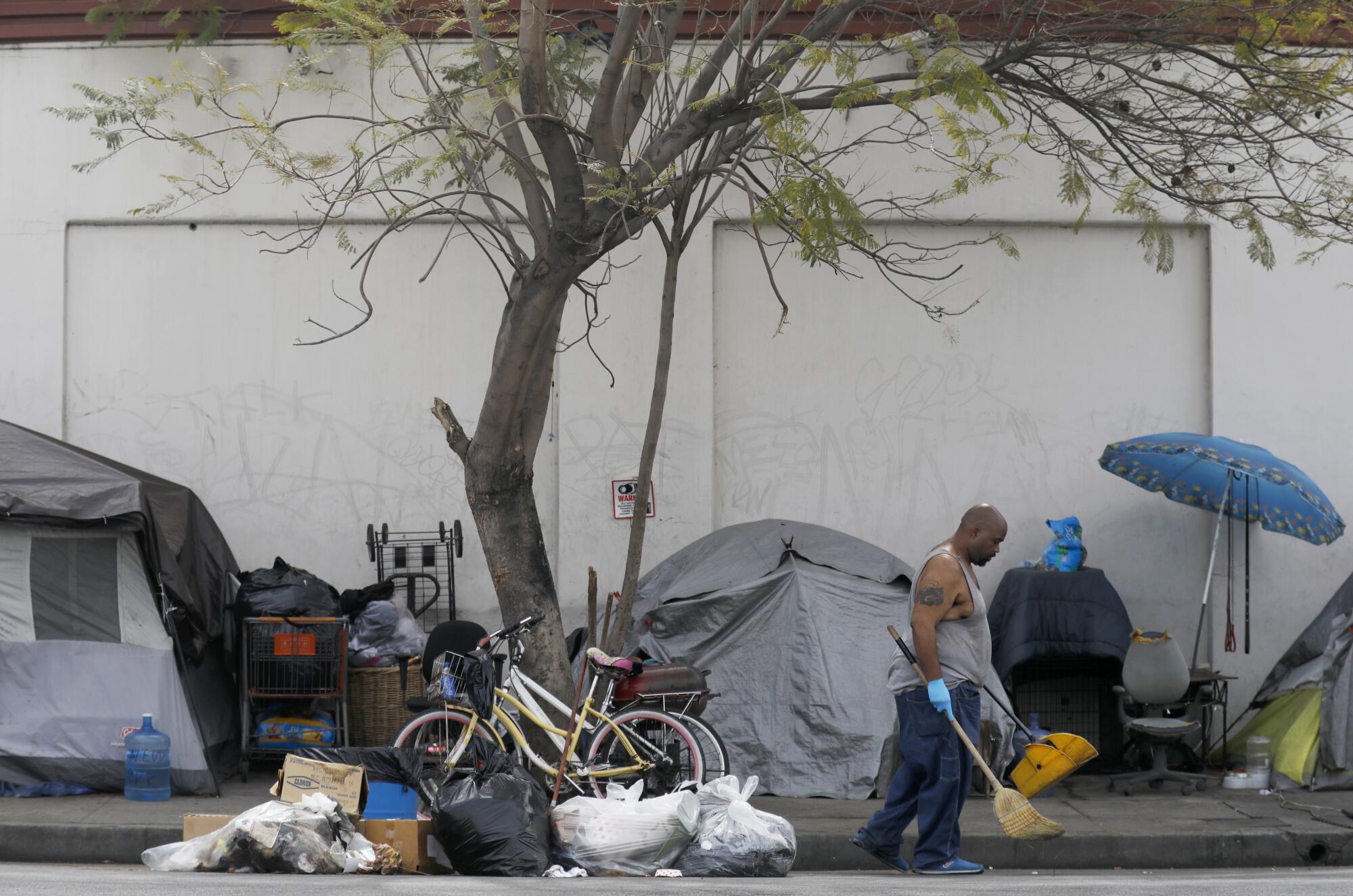
Big Mama didn’t know about the program, but she was happy to take advantage of the food and clothing the outreach workers brought.
One night in June, a chilly breeze cut through the streets. A trash bag skittered across Broadway Place. Outside her tent, Big Mama threaded a rope through her plastic armchairs, a safeguard against thieves.
She and Top Shelf were feeling good, their moods lightened by an afternoon of drinking and smoking. The lights of downtown Los Angeles looked close enough to touch.
Most of their neighbors were inside tents, playing video games or watching movies on their cellphones, electricity bootlegged from a city utility box.
Big Mama’s and Top Shelf’s laughter stopped when a young man they didn’t recognize wandered by.
“Where you going?” Top Shelf asked, never one for simple hellos.
He whispered his answer, and they grew serious. He was alone, young and vulnerable. He wore only athletic shorts, a T-shirt and a pair of sandals, and he looked as cold as the wind.
“Well, you ain’t going nowhere dressed like that,” Top Shelf said.
She went into her tent and came out with dark blue sweat pants. She insisted that he put them on.
He said his name was Xavier. He was 24.
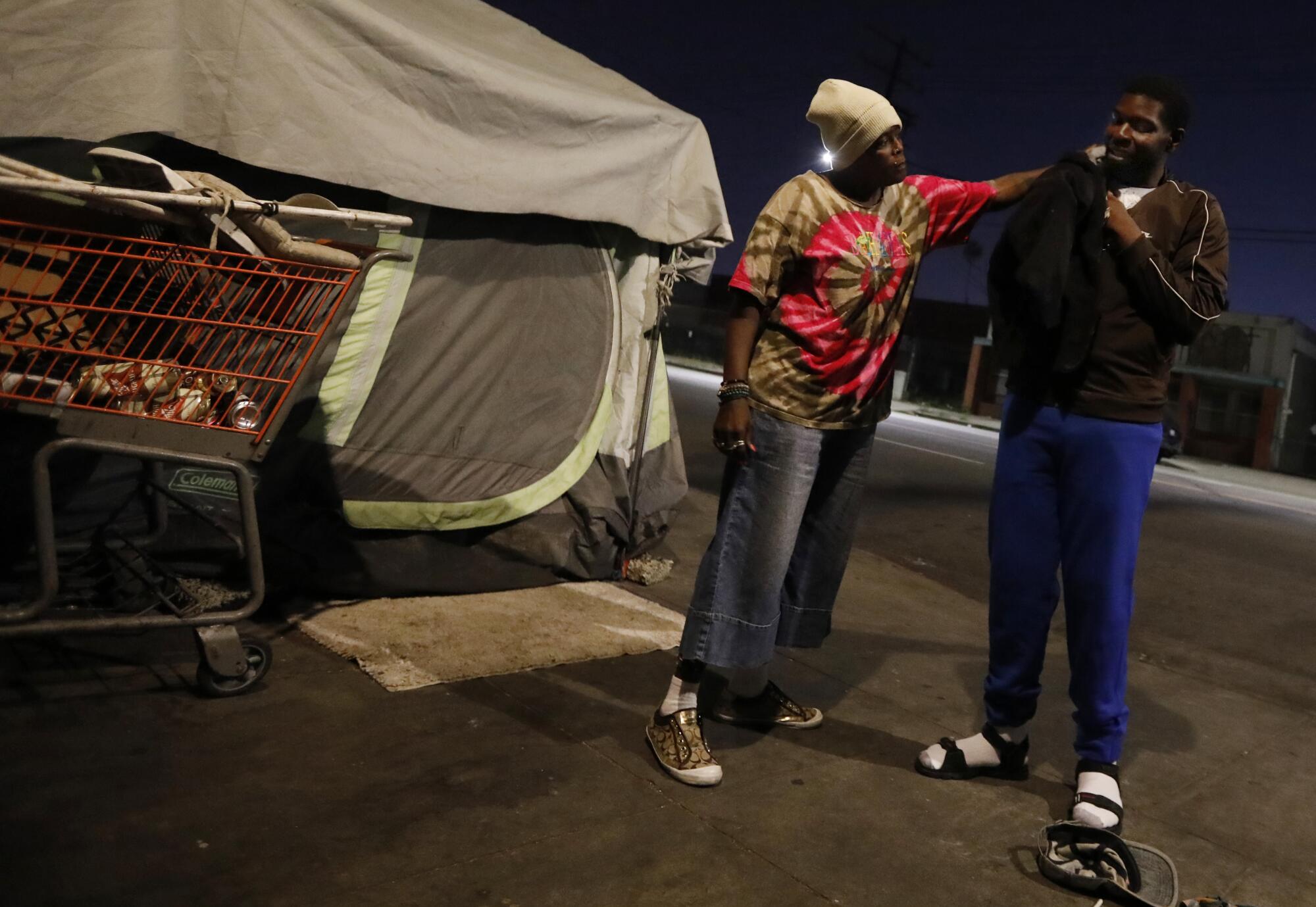
Big Mama was wearing a windbreaker. She took it off, and he put that on as well. She went into her tent and returned with a shirt and white socks. Xavier looked stunned. He was embarrassed by the help, but he was not too proud to know he needed it.
“You’ve been blessed today,” Big Mama said.
Xavier stood silently, then stepped toward her and kissed her on the forehead.
“Now be careful,” Big Mama said. “Say a prayer and talk to God.”
::
Big Mama knew that many people wished the homeless would go away.
Police cruisers blinded them with their spotlights. Cars raced a few feet from their beds and spun doughnuts in a nearby intersection. Punks shot paintballs at them.
Some businesses — the mom-and-pop markets, the laundromats — catered to them, but others railed against them, citing health and safety risks in emails to city officials and the police.
Shame on the city of Los Angeles for abandoning its law-abiding citizens to be abused and terrorized like this. We try to bring business and jobs to this area, and we get crap for it.
Their words captured the desperation and frustration they faced each day, coming to work and watching the problem get worse.
Our businesses suffer both financially as customers shy away from them because of the condition they have to walk through to get to them and physically as fires erupt at encampments and our homes lose value due to these issues. Our community looks like a garbage dump and a scene out of a Walking Dead episode, and services are not available to fix the problem.
In defiance of city regulations, a few companies built fences on the sidewalks so no one could live on them. But the greatest disruption came from the Sanitation Bureau.
Sweep notices went up two days in advance, giving Big Mama, Top Shelf and the others time to pack up their tents and belongings — mattresses, blankets, clothing, food, water, pots, pans, dishes, medical records, photographs — and haul them across the street.
But in two instances 10 days apart, notices went up, and the cleaning crews never showed up. All the work moving their stuff was for nothing, and no one bothered to explain why.
“I’m crying out for help right now, yes,” Big Mama said. “I can’t go through it no more. It’s driving me crazy. I can’t take it no more.”
::
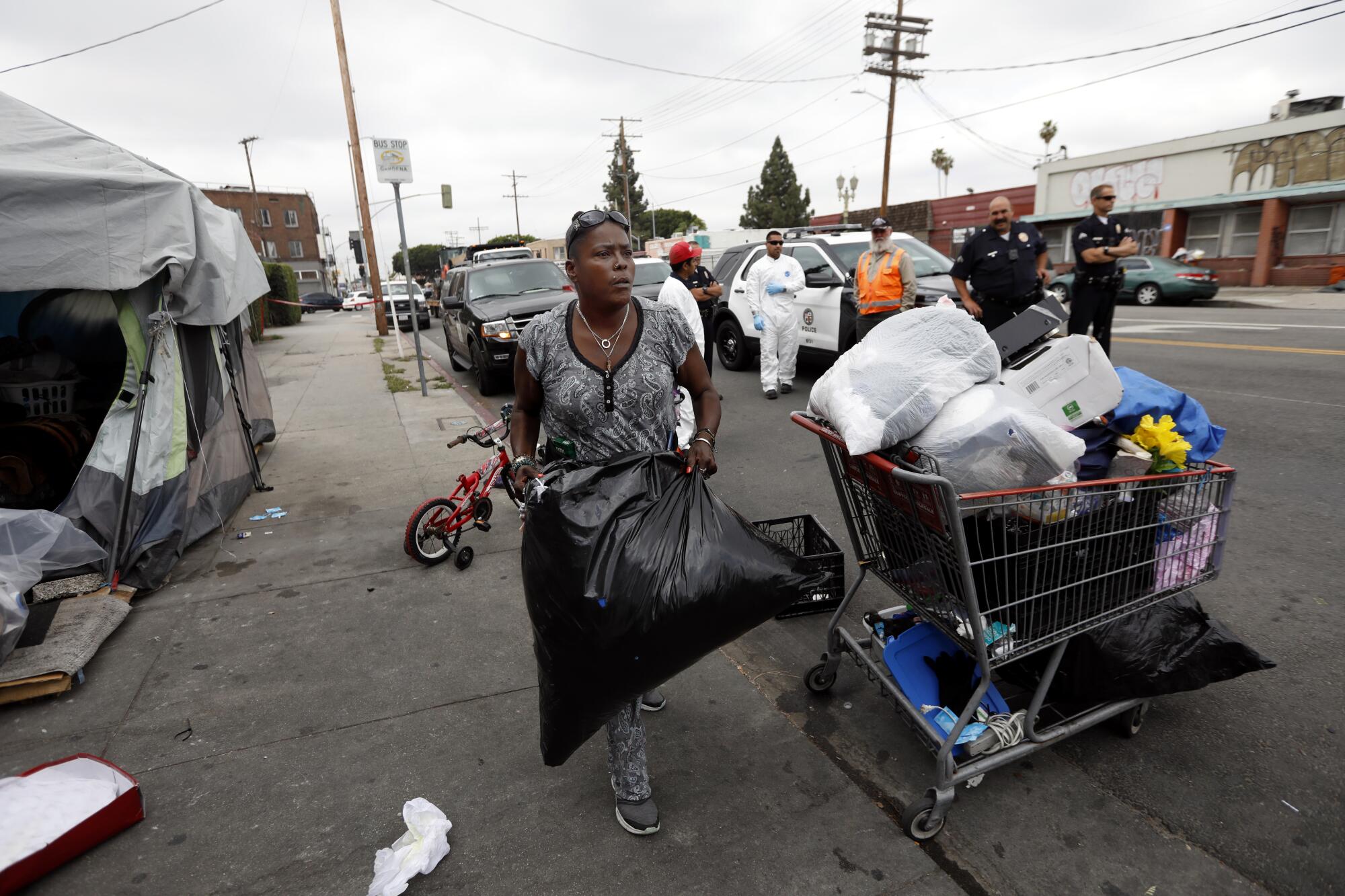
When the third notice went up, no one paid attention. Then, a little past 8 a.m., the street began to echo with the sound of trash trucks, a flatbed hauling a skip loader, a stake bed and the white city-issued pickups.
The Los Angeles Police Department parked a black-and-white SUV at each end of the block.
Big Mama and her neighbors had to scramble.
Men in white jumpsuits, face masks and orange safety vests shouted warnings.
“Two minutes!” barked a man in a blue hard hat.
Big Mama struggled to empty her tent. She filled a shopping cart with black plastic bags containing her clothes. Top Shelf angled wooden pallets against a wall. Niecy, who had fallen out of favor with her friends, lived a block away.
“One more minute!” yelled the man in the blue helmet.
“Can y’all come and help me with my mattress?” Big Mama shouted.
When asked why the cleanup hadn’t taken place the week before or the week before that, Jerry Ballesteros, one of the police officers in charge, said that sanitation crews are assigned to as many as five locations a day. If one site takes too long, then the others are pushed back.
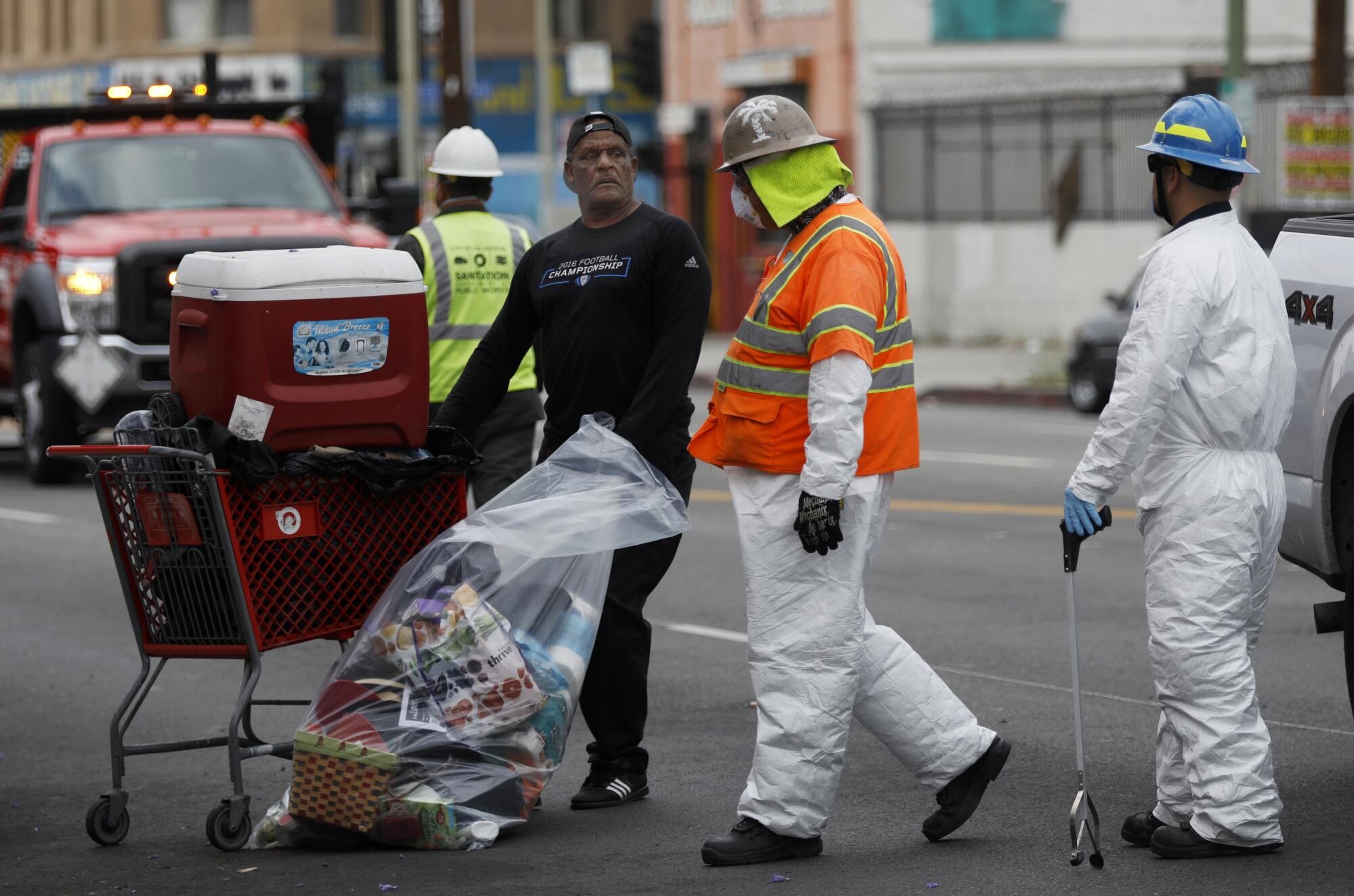
Ballesteros, known on the streets as Sarge, was counting the months until his retirement.
Twenty-six years before, he had been in a shootout just south of Broadway Place, where he and his partner were ambushed by gang members. Both officers survived.
Now Ballesteros was protecting sanitation crews who faced threats he could do nothing about: hepatitis and typhus.
“Do you think I like doing this?” he said. “This ain’t police work.”
“OK, time’s up!” yelled the man in the blue helmet.
Workers began emptying tents that hadn’t been moved, bagging clothes and shoes and collecting drugs, needles and bottles of urine. Others raked and shoveled whatever else was left behind: a card table, a barbecue grill, a boogie board, an umbrella, chairs, a hassock, pallets, pieces of cardboard, empty marijuana containers, a meth pipe.
Guy lines were cut. Tents collapsed. Aluminum poles and heaps of nylon were hauled to the corner.
The trash trucks ground everything into scraps.
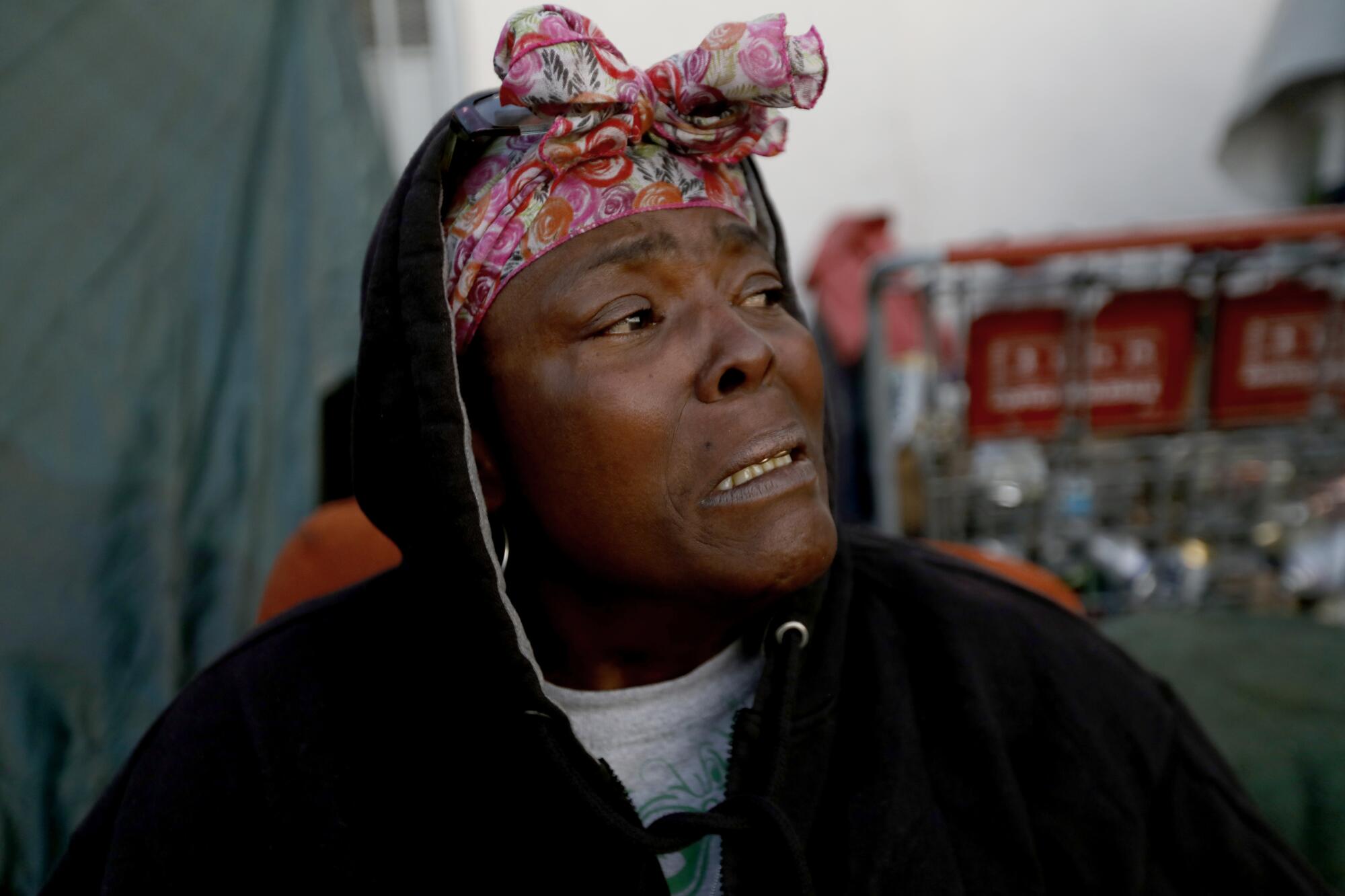
The tines of rakes bristled against the concrete, soon sprayed with bleach and water.
Big Mama and Top Shelf, Horace, Wendy and X watched from across the street. They stood among their possessions like refugees. Horace’s T-shirt read, “Blame Poverty.”
“Don’t treat us like nobody just because we’re homeless!” X said.
By late morning they began moving back and started hunting for eyeglasses, medical cards and paperwork.
Before the day was over, outreach workers had replaced $600 worth of tents, air mattresses, tarps and air pumps. In a game of whack-a-mole, one agency destroyed and another rebuilt.
Big Mama couldn’t take it.
“You can freeze to death on the streets, you can burn up on the streets, you can starve on the streets,” she said. “I have no more energy for any of this.”
More to Read
Sign up for Essential California
The most important California stories and recommendations in your inbox every morning.
You may occasionally receive promotional content from the Los Angeles Times.

